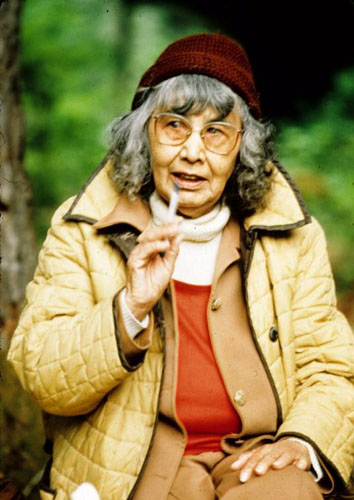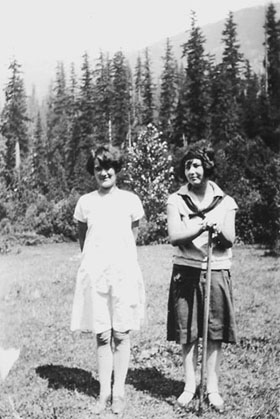
The Women's Legacy Project of Snohomish County, Washington seeks to honor our foremothers by recording and sharing their personal histories, their ability to adapt to the forces of change and their constant vigilance as stewards of the diverse cultures of our society.
www.snohomishwomenslegacy.org WLP Story # 35 |
|
Jean Bedal Fish: Elder of the Sauk-Suiattle Tribe By Louise Lindgren Jean Bedal Fish, elder of the Sauk-Suiattle Tribe, was dedicated to the preservation of her Native American culture. Her legacy included not only the recognition of her mother’s tribe, but its written history as well. Jean was the daughter homesteader James Bedal and Susan Wa-wet-kin, only daughter of Sauk Chief John Wa-wet-kin. Born in 1907 in the cedar cabin Bedal built on his homestead, Fish entered a world dominated by towering trees, the Sauk river, and rain. The sounds of two languages entered her consciousness from the cradle. One language, English, could be written – the other, Lushootseed, remained only sounds, with no written record. The Bedal children attended school on their own homestead southeast of Darrington and in Fish’s words, “eighteen miles from nowhere.” Learning to read and write in English was important, but after school she followed her mother’s instructions, given in the Sauk language and by example. Her father voiced no displeasure at the arrangement as long as his children kept up their English studies. Jean Bedal’s first teacher was a lonely lady who found her surroundings highly disagreeable. She stayed only one term, but in that time made a lasting impression on the girl. When a sewing assignment, a doll’s dress, turned out badly, the angry teacher threw it in the fire. This prompted a strong parental protest and words that were a prophetic compliment, “Our Jeannie doesn’t need to be taught how to sew – she learns by observation!” |
 Jean Bedal, July 23, 1986 when Jean and Edith were teaching at David Cameron's week-long class on the history of Monte Cristo, held at Monte Cristo. Photograph Courtesy Louise Lindgren, 1986. |
 Jean Bedal on the right, circa 1930? |
One Christmas gathering was
memorable for the drama that began at 3:00 a.m. A man rushed in shouting,
“Pray, pray – the river is coming!” The Sauk river had become a raging torrent
in full flood. For three days people listened to the deep earthshaking rumble of
huge boulders under the water. Catholic prayers of her Sauk relatives were
spoken in a language new to Jean – the Chelan dialect used by the traveling
priests -- more learning by observation for a young girl pacing the rain-sodden
riverbank. In a few years, another language was added to her mental storehouse. Her high school principal was a Catholic and tutored her in Latin, a language that Jean Bedal Fish could speak even in her elder years. James Bedal’s illness eventually caused such hardship in the family that the young woman felt the need to stay and help on the original homestead two long hard winters. That put her behind one year for graduation and another year before she had the opportunity to go to college in Bellingham for a quarter of teacher training. Money for tuition came from her small savings earned doing work unusual for women of the time -- working for the Forest Service, checking on hikers who passed the homestead on their way into a restricted logging area. Even more unusual, both she and her sister Edith were excellent horse-packers and guides. Interviewed in her elder years, Jean Fish remembered, “I guess I was about six or seven years old. There was [my Dad’s] horse by the name of Pete, … a wonderful horse. So I used to sneak to the barn and had a hard time putting the saddle on – it was heavy. And then I tried to tighten the strap, and the horse would just blow his belly up every time. But I led him to a log to get on him and rode maybe a quarter mile and back again.” |
| At age 13, Jean led two attorneys
into the mountains as a solo guide trip. A few years later she was lone packer
on a 50 mile round trip to both White and Indian passes. That trip included
dealing with a mean horse after spending the night at the pass and tracking down
horses who had wandered off in the middle of the night. After delivering the
family safely to the railway station in fading light, she returned to the
homestead in the dark. Another skill, also learned by observation and practice, was put to use for the rest of her life – cooking. She cooked for family, Forest Service workers, and beginning in 1929, guests at the hotel in Monte Cristo. In 1932, she married Russell Fish, son of the proprietor. |
Jean and Edith with their packhorses at the Penn Mining Co. office at Monte Cristo, circa 1930 |
From a dual-culture upbringing, through experiences of the wider world, to the homecoming of a tribe complete and recognized in a many-cultured country, Jean Bedal Fish saw and experienced it all.
1. Interview with Jean Fish by Louise Lindgren, February 20, 1990
2. Jean Bedal Fish and Edith Bedal, with editorial assistance by Astrida R. Blukis Onat, Two Voices: A History of the Sauk and Suiattle People and Sauk Country Experiences, privately published for the Memorial Pow-Wow of June 9, 2000
See also the biographical article about James Bedal and Jean's sister Edith in the Skagit River Journal of History & Folklore.
Revised and edited from a Third Age News (now Senior Source) Article published April 1991